An In-Depth Study of the Turkish Constitution's Key Features
VerifiedAdded on 2022/09/12
|5
|1622
|62
Essay
AI Summary
This essay provides a comprehensive analysis of the Turkish Constitution, beginning with its historical context, including the 1876 and 1908 revisions and the 1982 adoption after the 1980-1983 military junta. The document explores the Constitution's affirmation of Turkey as a secular and democratic republic, detailing the structure of the government, including the role of the Turkish Grand National Assembly, the division of powers among legislative, executive, and judicial branches, and the principles of the Republic. It outlines the bill of rights, fundamental rights, and freedoms, including the right to life, freedom from forced labor, individual rights, social life protection, and freedom of speech and association. The essay examines the concept of national sovereignty, the role of the judiciary, and the powers of the President and Council of Ministers. It also discusses the evolution of the Constitution, including the 2010 reforms and their impact on human rights and the military's influence. Key articles related to human rights, freedom of speech, and labor rights are highlighted. The essay references various academic sources to support its analysis.
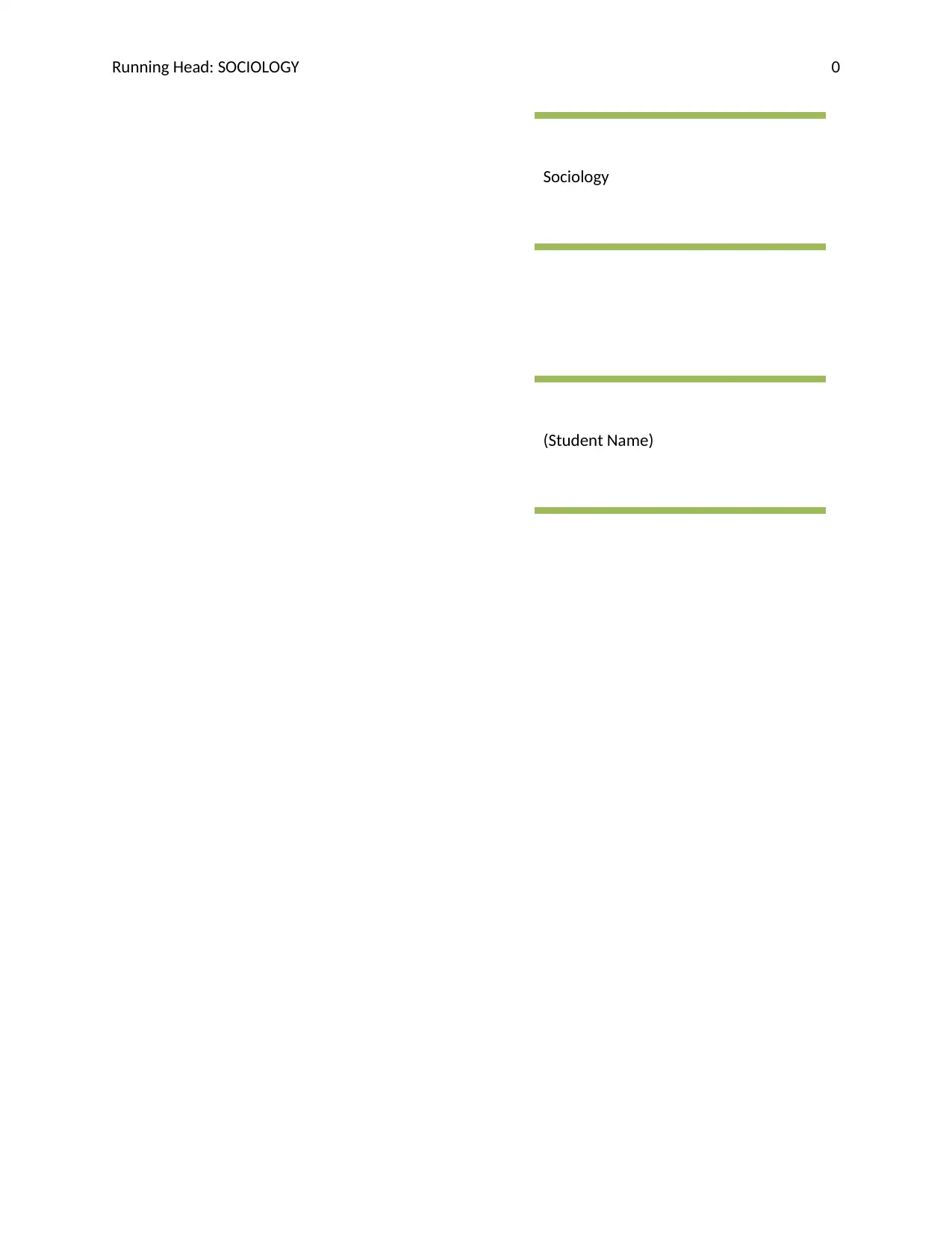
Running Head: SOCIOLOGY 0
Sociology
(Student Name)
Sociology
(Student Name)
Paraphrase This Document
Need a fresh take? Get an instant paraphrase of this document with our AI Paraphraser
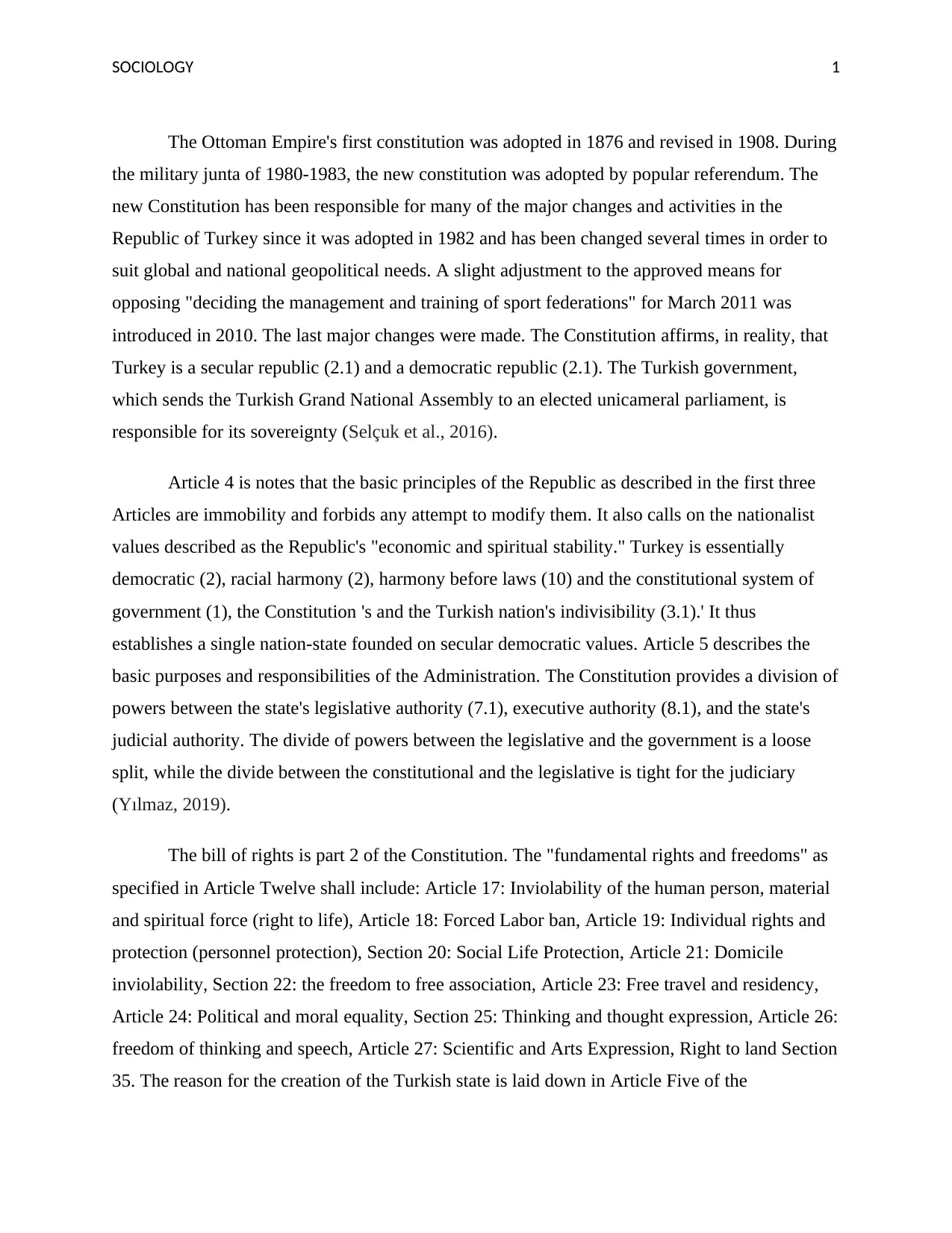
SOCIOLOGY 1
The Ottoman Empire's first constitution was adopted in 1876 and revised in 1908. During
the military junta of 1980-1983, the new constitution was adopted by popular referendum. The
new Constitution has been responsible for many of the major changes and activities in the
Republic of Turkey since it was adopted in 1982 and has been changed several times in order to
suit global and national geopolitical needs. A slight adjustment to the approved means for
opposing "deciding the management and training of sport federations" for March 2011 was
introduced in 2010. The last major changes were made. The Constitution affirms, in reality, that
Turkey is a secular republic (2.1) and a democratic republic (2.1). The Turkish government,
which sends the Turkish Grand National Assembly to an elected unicameral parliament, is
responsible for its sovereignty (Selçuk et al., 2016).
Article 4 is notes that the basic principles of the Republic as described in the first three
Articles are immobility and forbids any attempt to modify them. It also calls on the nationalist
values described as the Republic's "economic and spiritual stability." Turkey is essentially
democratic (2), racial harmony (2), harmony before laws (10) and the constitutional system of
government (1), the Constitution 's and the Turkish nation's indivisibility (3.1).' It thus
establishes a single nation-state founded on secular democratic values. Article 5 describes the
basic purposes and responsibilities of the Administration. The Constitution provides a division of
powers between the state's legislative authority (7.1), executive authority (8.1), and the state's
judicial authority. The divide of powers between the legislative and the government is a loose
split, while the divide between the constitutional and the legislative is tight for the judiciary
(Yılmaz, 2019).
The bill of rights is part 2 of the Constitution. The "fundamental rights and freedoms" as
specified in Article Twelve shall include: Article 17: Inviolability of the human person, material
and spiritual force (right to life), Article 18: Forced Labor ban, Article 19: Individual rights and
protection (personnel protection), Section 20: Social Life Protection, Article 21: Domicile
inviolability, Section 22: the freedom to free association, Article 23: Free travel and residency,
Article 24: Political and moral equality, Section 25: Thinking and thought expression, Article 26:
freedom of thinking and speech, Article 27: Scientific and Arts Expression, Right to land Section
35. The reason for the creation of the Turkish state is laid down in Article Five of the
The Ottoman Empire's first constitution was adopted in 1876 and revised in 1908. During
the military junta of 1980-1983, the new constitution was adopted by popular referendum. The
new Constitution has been responsible for many of the major changes and activities in the
Republic of Turkey since it was adopted in 1982 and has been changed several times in order to
suit global and national geopolitical needs. A slight adjustment to the approved means for
opposing "deciding the management and training of sport federations" for March 2011 was
introduced in 2010. The last major changes were made. The Constitution affirms, in reality, that
Turkey is a secular republic (2.1) and a democratic republic (2.1). The Turkish government,
which sends the Turkish Grand National Assembly to an elected unicameral parliament, is
responsible for its sovereignty (Selçuk et al., 2016).
Article 4 is notes that the basic principles of the Republic as described in the first three
Articles are immobility and forbids any attempt to modify them. It also calls on the nationalist
values described as the Republic's "economic and spiritual stability." Turkey is essentially
democratic (2), racial harmony (2), harmony before laws (10) and the constitutional system of
government (1), the Constitution 's and the Turkish nation's indivisibility (3.1).' It thus
establishes a single nation-state founded on secular democratic values. Article 5 describes the
basic purposes and responsibilities of the Administration. The Constitution provides a division of
powers between the state's legislative authority (7.1), executive authority (8.1), and the state's
judicial authority. The divide of powers between the legislative and the government is a loose
split, while the divide between the constitutional and the legislative is tight for the judiciary
(Yılmaz, 2019).
The bill of rights is part 2 of the Constitution. The "fundamental rights and freedoms" as
specified in Article Twelve shall include: Article 17: Inviolability of the human person, material
and spiritual force (right to life), Article 18: Forced Labor ban, Article 19: Individual rights and
protection (personnel protection), Section 20: Social Life Protection, Article 21: Domicile
inviolability, Section 22: the freedom to free association, Article 23: Free travel and residency,
Article 24: Political and moral equality, Section 25: Thinking and thought expression, Article 26:
freedom of thinking and speech, Article 27: Scientific and Arts Expression, Right to land Section
35. The reason for the creation of the Turkish state is laid down in Article Five of the
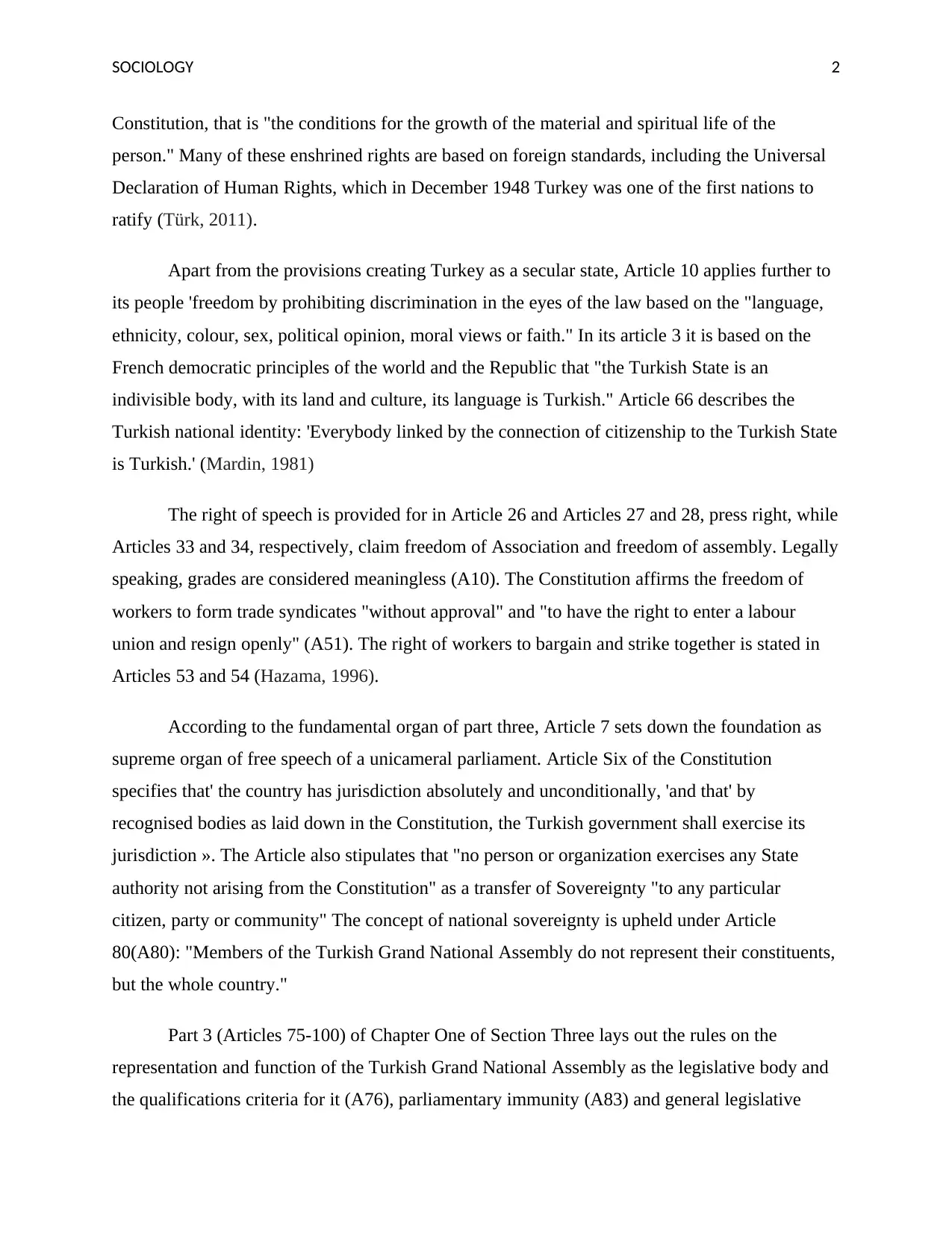
SOCIOLOGY 2
Constitution, that is "the conditions for the growth of the material and spiritual life of the
person." Many of these enshrined rights are based on foreign standards, including the Universal
Declaration of Human Rights, which in December 1948 Turkey was one of the first nations to
ratify (Türk, 2011).
Apart from the provisions creating Turkey as a secular state, Article 10 applies further to
its people 'freedom by prohibiting discrimination in the eyes of the law based on the "language,
ethnicity, colour, sex, political opinion, moral views or faith." In its article 3 it is based on the
French democratic principles of the world and the Republic that "the Turkish State is an
indivisible body, with its land and culture, its language is Turkish." Article 66 describes the
Turkish national identity: 'Everybody linked by the connection of citizenship to the Turkish State
is Turkish.' (Mardin, 1981)
The right of speech is provided for in Article 26 and Articles 27 and 28, press right, while
Articles 33 and 34, respectively, claim freedom of Association and freedom of assembly. Legally
speaking, grades are considered meaningless (A10). The Constitution affirms the freedom of
workers to form trade syndicates "without approval" and "to have the right to enter a labour
union and resign openly" (A51). The right of workers to bargain and strike together is stated in
Articles 53 and 54 (Hazama, 1996).
According to the fundamental organ of part three, Article 7 sets down the foundation as
supreme organ of free speech of a unicameral parliament. Article Six of the Constitution
specifies that' the country has jurisdiction absolutely and unconditionally, 'and that' by
recognised bodies as laid down in the Constitution, the Turkish government shall exercise its
jurisdiction ». The Article also stipulates that "no person or organization exercises any State
authority not arising from the Constitution" as a transfer of Sovereignty "to any particular
citizen, party or community" The concept of national sovereignty is upheld under Article
80(A80): "Members of the Turkish Grand National Assembly do not represent their constituents,
but the whole country."
Part 3 (Articles 75-100) of Chapter One of Section Three lays out the rules on the
representation and function of the Turkish Grand National Assembly as the legislative body and
the qualifications criteria for it (A76), parliamentary immunity (A83) and general legislative
Constitution, that is "the conditions for the growth of the material and spiritual life of the
person." Many of these enshrined rights are based on foreign standards, including the Universal
Declaration of Human Rights, which in December 1948 Turkey was one of the first nations to
ratify (Türk, 2011).
Apart from the provisions creating Turkey as a secular state, Article 10 applies further to
its people 'freedom by prohibiting discrimination in the eyes of the law based on the "language,
ethnicity, colour, sex, political opinion, moral views or faith." In its article 3 it is based on the
French democratic principles of the world and the Republic that "the Turkish State is an
indivisible body, with its land and culture, its language is Turkish." Article 66 describes the
Turkish national identity: 'Everybody linked by the connection of citizenship to the Turkish State
is Turkish.' (Mardin, 1981)
The right of speech is provided for in Article 26 and Articles 27 and 28, press right, while
Articles 33 and 34, respectively, claim freedom of Association and freedom of assembly. Legally
speaking, grades are considered meaningless (A10). The Constitution affirms the freedom of
workers to form trade syndicates "without approval" and "to have the right to enter a labour
union and resign openly" (A51). The right of workers to bargain and strike together is stated in
Articles 53 and 54 (Hazama, 1996).
According to the fundamental organ of part three, Article 7 sets down the foundation as
supreme organ of free speech of a unicameral parliament. Article Six of the Constitution
specifies that' the country has jurisdiction absolutely and unconditionally, 'and that' by
recognised bodies as laid down in the Constitution, the Turkish government shall exercise its
jurisdiction ». The Article also stipulates that "no person or organization exercises any State
authority not arising from the Constitution" as a transfer of Sovereignty "to any particular
citizen, party or community" The concept of national sovereignty is upheld under Article
80(A80): "Members of the Turkish Grand National Assembly do not represent their constituents,
but the whole country."
Part 3 (Articles 75-100) of Chapter One of Section Three lays out the rules on the
representation and function of the Turkish Grand National Assembly as the legislative body and
the qualifications criteria for it (A76), parliamentary immunity (A83) and general legislative
⊘ This is a preview!⊘
Do you want full access?
Subscribe today to unlock all pages.

Trusted by 1+ million students worldwide
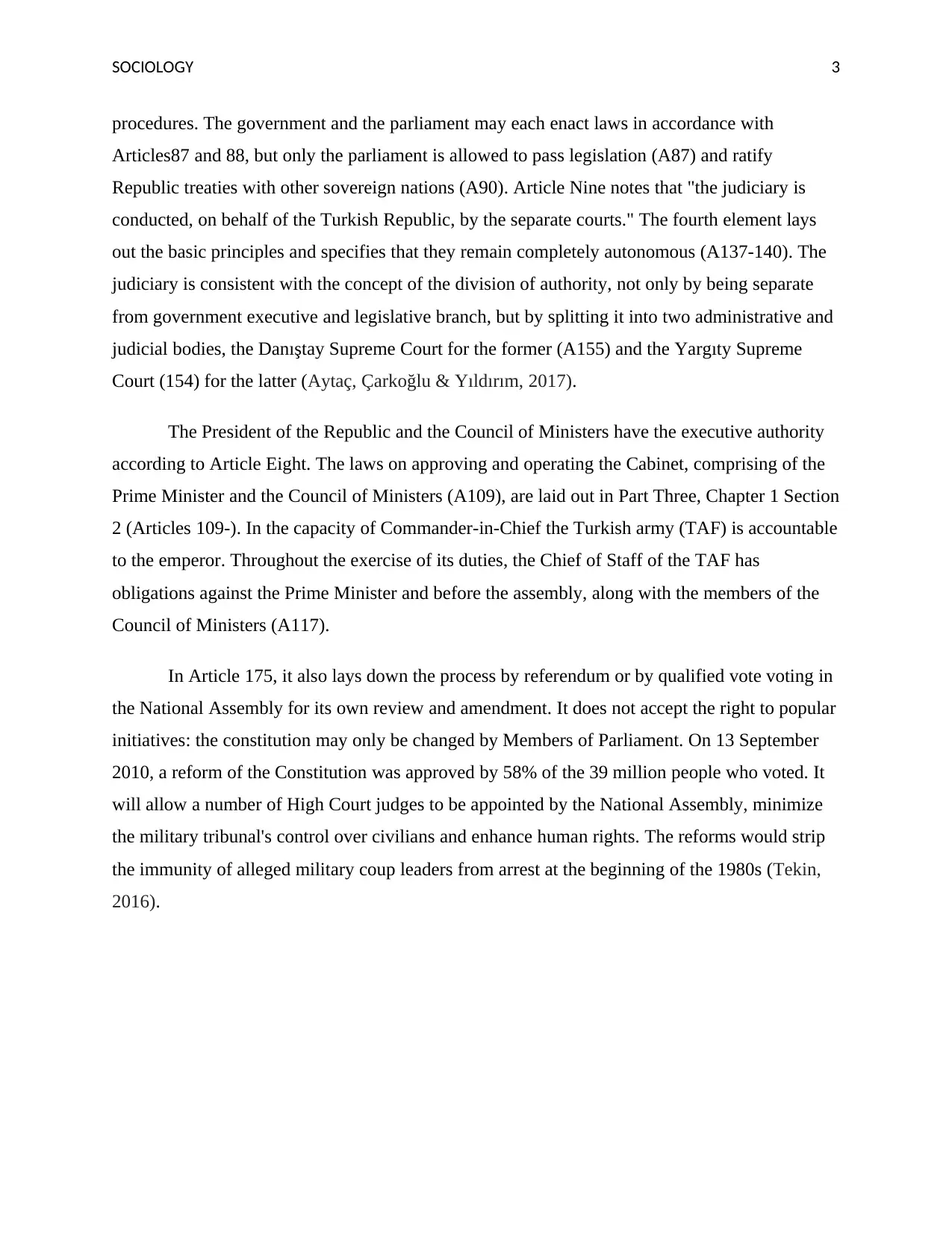
SOCIOLOGY 3
procedures. The government and the parliament may each enact laws in accordance with
Articles87 and 88, but only the parliament is allowed to pass legislation (A87) and ratify
Republic treaties with other sovereign nations (A90). Article Nine notes that "the judiciary is
conducted, on behalf of the Turkish Republic, by the separate courts." The fourth element lays
out the basic principles and specifies that they remain completely autonomous (A137-140). The
judiciary is consistent with the concept of the division of authority, not only by being separate
from government executive and legislative branch, but by splitting it into two administrative and
judicial bodies, the Danıştay Supreme Court for the former (A155) and the Yargıty Supreme
Court (154) for the latter (Aytaç, Çarkoğlu & Yıldırım, 2017).
The President of the Republic and the Council of Ministers have the executive authority
according to Article Eight. The laws on approving and operating the Cabinet, comprising of the
Prime Minister and the Council of Ministers (A109), are laid out in Part Three, Chapter 1 Section
2 (Articles 109-). In the capacity of Commander-in-Chief the Turkish army (TAF) is accountable
to the emperor. Throughout the exercise of its duties, the Chief of Staff of the TAF has
obligations against the Prime Minister and before the assembly, along with the members of the
Council of Ministers (A117).
In Article 175, it also lays down the process by referendum or by qualified vote voting in
the National Assembly for its own review and amendment. It does not accept the right to popular
initiatives: the constitution may only be changed by Members of Parliament. On 13 September
2010, a reform of the Constitution was approved by 58% of the 39 million people who voted. It
will allow a number of High Court judges to be appointed by the National Assembly, minimize
the military tribunal's control over civilians and enhance human rights. The reforms would strip
the immunity of alleged military coup leaders from arrest at the beginning of the 1980s (Tekin,
2016).
procedures. The government and the parliament may each enact laws in accordance with
Articles87 and 88, but only the parliament is allowed to pass legislation (A87) and ratify
Republic treaties with other sovereign nations (A90). Article Nine notes that "the judiciary is
conducted, on behalf of the Turkish Republic, by the separate courts." The fourth element lays
out the basic principles and specifies that they remain completely autonomous (A137-140). The
judiciary is consistent with the concept of the division of authority, not only by being separate
from government executive and legislative branch, but by splitting it into two administrative and
judicial bodies, the Danıştay Supreme Court for the former (A155) and the Yargıty Supreme
Court (154) for the latter (Aytaç, Çarkoğlu & Yıldırım, 2017).
The President of the Republic and the Council of Ministers have the executive authority
according to Article Eight. The laws on approving and operating the Cabinet, comprising of the
Prime Minister and the Council of Ministers (A109), are laid out in Part Three, Chapter 1 Section
2 (Articles 109-). In the capacity of Commander-in-Chief the Turkish army (TAF) is accountable
to the emperor. Throughout the exercise of its duties, the Chief of Staff of the TAF has
obligations against the Prime Minister and before the assembly, along with the members of the
Council of Ministers (A117).
In Article 175, it also lays down the process by referendum or by qualified vote voting in
the National Assembly for its own review and amendment. It does not accept the right to popular
initiatives: the constitution may only be changed by Members of Parliament. On 13 September
2010, a reform of the Constitution was approved by 58% of the 39 million people who voted. It
will allow a number of High Court judges to be appointed by the National Assembly, minimize
the military tribunal's control over civilians and enhance human rights. The reforms would strip
the immunity of alleged military coup leaders from arrest at the beginning of the 1980s (Tekin,
2016).
Paraphrase This Document
Need a fresh take? Get an instant paraphrase of this document with our AI Paraphraser
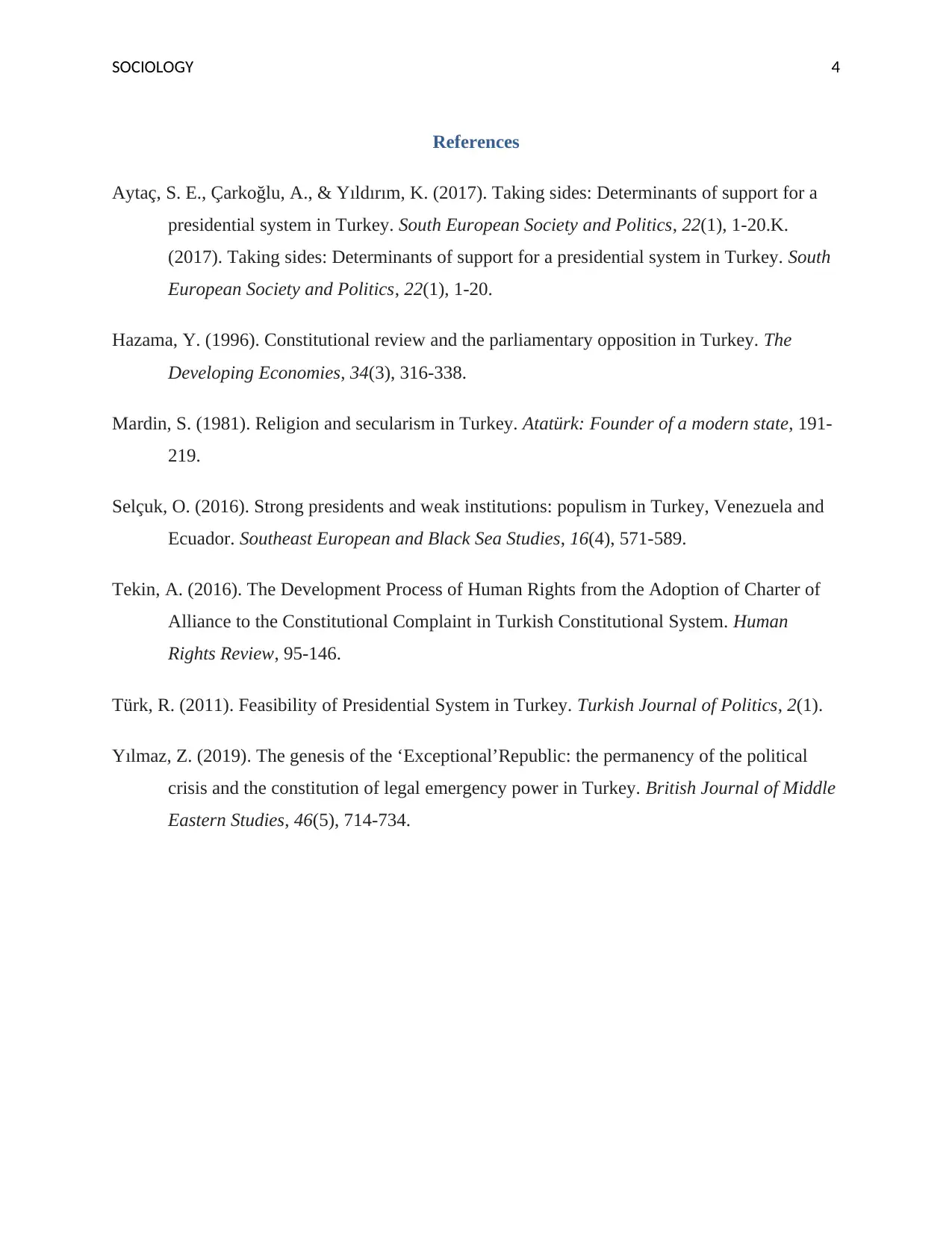
SOCIOLOGY 4
References
Aytaç, S. E., Çarkoğlu, A., & Yıldırım, K. (2017). Taking sides: Determinants of support for a
presidential system in Turkey. South European Society and Politics, 22(1), 1-20.K.
(2017). Taking sides: Determinants of support for a presidential system in Turkey. South
European Society and Politics, 22(1), 1-20.
Hazama, Y. (1996). Constitutional review and the parliamentary opposition in Turkey. The
Developing Economies, 34(3), 316-338.
Mardin, S. (1981). Religion and secularism in Turkey. Atatürk: Founder of a modern state, 191-
219.
Selçuk, O. (2016). Strong presidents and weak institutions: populism in Turkey, Venezuela and
Ecuador. Southeast European and Black Sea Studies, 16(4), 571-589.
Tekin, A. (2016). The Development Process of Human Rights from the Adoption of Charter of
Alliance to the Constitutional Complaint in Turkish Constitutional System. Human
Rights Review, 95-146.
Türk, R. (2011). Feasibility of Presidential System in Turkey. Turkish Journal of Politics, 2(1).
Yılmaz, Z. (2019). The genesis of the ‘Exceptional’Republic: the permanency of the political
crisis and the constitution of legal emergency power in Turkey. British Journal of Middle
Eastern Studies, 46(5), 714-734.
References
Aytaç, S. E., Çarkoğlu, A., & Yıldırım, K. (2017). Taking sides: Determinants of support for a
presidential system in Turkey. South European Society and Politics, 22(1), 1-20.K.
(2017). Taking sides: Determinants of support for a presidential system in Turkey. South
European Society and Politics, 22(1), 1-20.
Hazama, Y. (1996). Constitutional review and the parliamentary opposition in Turkey. The
Developing Economies, 34(3), 316-338.
Mardin, S. (1981). Religion and secularism in Turkey. Atatürk: Founder of a modern state, 191-
219.
Selçuk, O. (2016). Strong presidents and weak institutions: populism in Turkey, Venezuela and
Ecuador. Southeast European and Black Sea Studies, 16(4), 571-589.
Tekin, A. (2016). The Development Process of Human Rights from the Adoption of Charter of
Alliance to the Constitutional Complaint in Turkish Constitutional System. Human
Rights Review, 95-146.
Türk, R. (2011). Feasibility of Presidential System in Turkey. Turkish Journal of Politics, 2(1).
Yılmaz, Z. (2019). The genesis of the ‘Exceptional’Republic: the permanency of the political
crisis and the constitution of legal emergency power in Turkey. British Journal of Middle
Eastern Studies, 46(5), 714-734.
1 out of 5
Related Documents
Your All-in-One AI-Powered Toolkit for Academic Success.
+13062052269
info@desklib.com
Available 24*7 on WhatsApp / Email
![[object Object]](/_next/static/media/star-bottom.7253800d.svg)
Unlock your academic potential
Copyright © 2020–2025 A2Z Services. All Rights Reserved. Developed and managed by ZUCOL.





